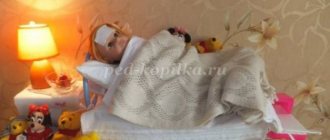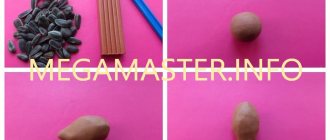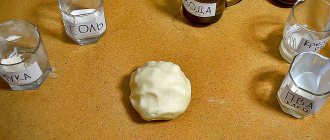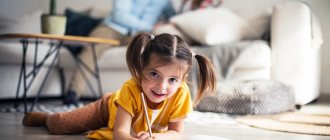MAGAZINE Preschooler.RF
Lesson summary for the senior group (5 – 6 years old) “My small homeland - Orenburg”Integration of educational areas: “Communication”
,
“Cognition”
,
“Reading fiction”
,
“Music”
.
Types of children's activities: communicative, perception of fiction, musical and artistic.
Goals: to give children an idea of what the Motherland, native land is. Introduce you to the map and symbols of the Russian Federation, form an idea of your small Motherland, clarify and expand knowledge about your hometown; develop coherent speech, activate vocabulary on the topic, cultivate love for the native land.
Planned results: has an idea about his hometown; knows the concept of “symbolism”
, formulates answers to the teacher’s questions.
Materials and equipment: illustrations of the capital of Russia, the city of Orenburg, sights of the city and nature of the native land, recording of the anthem of Orenburg and the anthem of the Russian Federation.
Contents of organized children's activities
1. Organizational moment.
The song sounds: “Where does the Motherland begin?”
—What is the song about? (about the Motherland)
— Today we will talk about the Motherland.
2. Main part. Conversation about the Motherland
— Tell me, what is the Motherland? (Motherland is the country in which we were born and live. These are forests, fields, rivers. This is our city. This is the place where close people live: mother, father, grandfather, grandmother. This is the place where our kindergarten is located. This is a place that people miss when they are in a distant land. This is the most precious thing a person has. This is the land where our ancestors worked)
.
- Yes, each of you answered my question correctly.
– Now listen to a poem about the Motherland:
“What do we call Motherland? The house where you and I live, And the birch trees along which We walk next to our mother.
What do we call Motherland? A field with a thin spikelet, Our holidays and songs, A warm evening outside the window!”
- Homeland is the country in which we live.
- What is it called? (Russia)
— Tell us what you know about Russia? (children's answers)
— Russia is a big country. There are many cities, rivers, forests. What about the main city of our country? (Moscow)
— Moscow is the capital of our Motherland. We are proud of our country.
Russia - you are a great power! Your expanses are infinitely great, You have crowned with glory for all centuries, And you have no other way!
— There are many cities in Russia. Guys, tell me, what city do we live in?
(In Orenburg)
(showing map)
— Look, this is a map of Orenburg. Do you think Orenburg is big or small? (children's answers)
- Our city is large, there are many fields, forests, rivers, meadows.
— Guys, different peoples live in our city. What peoples live in our city? (Russians, Tatars, Chuvash, Mordovians, etc.)
They all live in peace and harmony.
Child:
What do we call Motherland? The house where you and I grow up And the birches along the road along which we walk.
What do we call Motherland? The sun is in the blue sky, And fragrant, golden Bread at the festive table.
What do we call Motherland? The land where you and I live.
Fizminutka:
Hello world. (hands up)
It's me!
(on the chest)
And all around is my country!
(spread)
The sun is burning in the sky
(up)
And the earth lies at your feet! (incline)
There are forests there!
(castle to the right)
And there are fields!
(lock to the left)
Here are friends
(turn head)
And here are friends. (right and left)
Hello, home - you are the best
(spread with a downward slope)
Hello, mighty native land!
(spread with an upward tilt)
Hello, my country!
(spread)
Hello world! Meet me!
— Guys, do you know that every country has its own symbols? Which? (coat of arms, flag, anthem)
- Look - this is the coat of arms of Russia. What is shown on it? (children's answers)
The state emblem of the Russian Federation is made in the form of a red quadrangular heraldic shield. Its lower corners are rounded, and its edges are pointed. The shield depicts a golden double-headed eagle with wings spread and raised upward. It is crowned with three crowns connected by ribbons. The eagle holds a scepter in its left paw, and an orb in its right paw. On his chest is depicted a small red shield, in which there is a silver rider on a silver horse and in a blue cloak. He strikes a black dragon with a silver spear, which is knocked over on its back. The color scheme of a golden double-headed eagle on a red background has been present in the coat of arms since the 15th-17th centuries. What does the coat of arms with the image of an eagle mean? This bird is the most majestic among all the others. Since ancient times, it has been a royal symbol of power. Eagles were depicted on monuments from the time of Peter the Great. Also, the three crowns depicted above the eagle's heads belong to this era. Now they symbolize the sovereignty of the Russian Federation and all its subjects. The scepter and the orb in its clutches represent a unified state and its power. A horseman striking a dragon with a spear is an ancient symbol of the defense of the Fatherland, the struggle of light against darkness and good against evil.
— The second symbol of the Russian Federation is the flag. The national flag is the face of the country, a symbol of independence.
- What colors do you see? (White blue red)
.
- What do these colors mean? (children's answers)
White color is a symbol of purity, honor and peace;
Blue color is the sky.
Red is the color of the sun, energy, strength, life.
— The third symbol is the anthem.
— Maybe some of you know what the anthem is? (children's answers)
Listening to the Russian anthem.
— A hymn is a solemn song. In what cases do you think it is performed?
Children: – It is performed on especially solemn occasions, during the raising of the state flag, during national holidays, during military rituals and sports competitions. When the anthem of any country is played, people listening to it stand up and men take off their hats. This is how respect for the country is shown.
-But our city of Orenburg has its own anthem. Let's listen to it.
— Guys, Russia is our big Motherland. Each person, and each of you, has a small homeland. Maybe some of you know what a small Motherland is?
— Small Motherland is the corner where we were born, the place where we live, where our home is, where people close and dear to us live.
Child:
Small Motherland is an island of land, Under the window there are currants, cherry blossoms, a curly apple tree, and under it a bench - Affectionate, my small Motherland!
3. Ball game “What is our city?”
— Now we’ll play a game where each of you must tell what our city is? I ask you a question: what is our city like?
– Our city... (beautiful, clean, green, modern, beloved, amazing, blooming, magnificent, hospitable, multinational, wonderful, wonderful)
.
— Do you love our city? (children's answers)
- Why do you love him? (I love Orenburg for what it has... (schools, squares, parks, gardens, home, friends)
(differentiated approach for strong children)
4. Summary of the lesson.
“The journey through our Motherland has come to an end. Today you learned a lot about the Motherland. Is it true?
— Namely: your family, your home is located in the city of Orenburg.
— And the city of Orenburg is in Russia.
- Well done boys!
| Next > |
Outline of a modeling lesson on the topic: “My Home” (preparatory group)
Productive activity “Modeling” Lesson plan on the topic: “My Home” in the preparatory group Goals: to develop children’s interest in modeling from plasticine;
To develop accuracy and perseverance in children. Objectives: to develop children’s understanding of home, city, native land; consolidate the ability to work in a stack, cut off excess parts of the columns, arrange parts of the building in a certain sequence; cultivate love and respect for your home and city; develop spatial imagination. Materials: stand templates cut out of cardboard (green, yellow), plasticine, stacks, boards for modeling, a ready-made sample of a plasticine house, napkins, a chest with demonstration material (pictures of the city, houses, wooden buildings). Work progress: V. Guys! Let's see what the magic chest has prepared for us today! (I take out photographs of recognizable “attractions” of my hometown) Q. What do you think is shown in the photograph? (children's answers) Absolutely right, these buildings - hospitals, pharmacies, cinemas, train stations - are located in our city. He will build a skyscraper and a stadium right on time. A kindergarten and a hospital, a line of shops. Even a house, I’ll tell you, Where my family lives, (I. Ilkh) V. And what else has our chest prepared for us, let’s see! (I take out pictures and photographs of residential buildings) V. All this was built by people, residents of our city, for you and me. Therefore, guys, we will also build a house for ourselves and our family. (I take out a finished sample of the product from the chest and an image of its step-by-step implementation) Q. For this you will need plasticine and your imagination! Productive activities under the guidance of a teacher. Tell the children that they need to roll a lot of columns, then make them the same length using a stack. Form a base on a template-stand in the form of a rectangle, place doors and windows on them, then assemble the walls of the house. At the same time, place the columns on top of each other. During the formation of the roof, you will also need columns, and each subsequent one should be smaller (a continuation of the wall is made on both sides in the form of a pyramid), after which the ridge is attached and the roof columns are attached to it. Near the house you can invite the children to make a bench or a tree. Outcome of the lesson: examination of buildings, discussion.
Attached files
univerfiles.com








